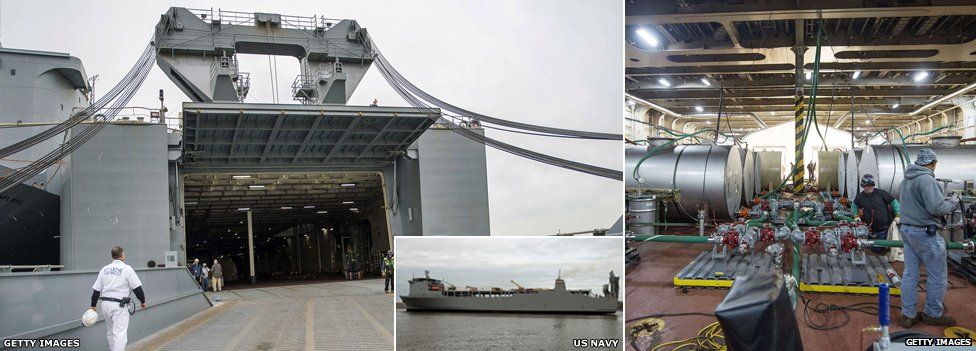Destroying Syria's chemical weapons
- Published

Syria has begun transferring some of its chemical weapons to an American cargo ship, equipped with special facilities to destroy the toxic material at sea. How will the process work?
The Russian-US deal to eliminate Syria's arsenal was drawn up last year after hundreds of people died in a sarin rocket attack in the Ghouta area outside Damascus on 21 August.
Syria was believed to possess 1,300 tonnes of chemical agents, including sulphur mustard (which forms mustard gas), nerve agents sarin and VX and their precursor ingredients.
The multinational mission to get rid of them, overseen by the United Nations Security Council and the Organisation for the Prohibition of Chemical Weapons (OPCW), was due to be completed by 30 June 2014. Syria has blamed fighting for delaying the handover of weapons.
US ship the MV Cape Ray will deal with the majority of the "priority" toxic substances by a process of hydrolysis, while in international waters in the Mediterranean Sea.
The ship is currently docked at the southern Italian port of Gioia Tauro. The UK will also deal with a quantity of the chemicals at a plant in Ellesmere Port.
Overview of the plan
Most of Syria's chemical weapons substances exist as separate materials that only create the highly toxic warfare agents when mixed together, according to the OPCW.
They are in liquid form and held in drums and bulk containers, rather than already placed in bombs or other munitions.
The Syrian government was responsible for moving the chemicals from storage sites around the country to the port city of Latakia.
From there, the five so-called "priority chemicals" were loaded on to a Danish cargo vessel, which then waited in international waters for each additional shipment before eventually setting sail for the Italian container port of Gioia Tauro.
A similar operation for the less dangerous "industrial grade" chemicals has taken place with a Norwegian vessel.
The first shipment of 16 tonnes of priority chemicals left Latakia on 7 January on a commercial Danish ship, accompanied by a naval escort from Russia, China, Denmark and Norway.
Once at Gioia Tauro, some 560 tonnes of material, including sulphur mustard and DF - the precursor to sarin - will be transferred on to the Cape Ray, which will sail into international waters to carry out neutralisation by hydrolysis.
Hydrolysis at sea
The Cape Ray is a former container ship that has been fitted out with two $5m (£3m) mobile hydrolysis systems, developed in 2013 by a specialist research wing of the US military.
During hydrolysis, the chemical agents are broken down with hot water and then further neutralised with sodium hydroxide - also known as caustic soda or lye.
The two titanium reactors on the Cape Ray can process five to 25 tonnes per day, dependent on the material being treated.
Some 63 specialist crew will work on the decommissioning, in addition to the ship's normal crew and extra security personnel.
The procedure is expected to take up to 90 days and generate about 1.5 million gallons (5.7 million litres) of waste.
Much of the effluent will still be hazardous but of a level of toxicity that can be disposed of in normal industrial processing. No chemicals will be dumped at sea, says the OPCW.
The US military has been using the system for a decade on land to dispose of its own chemical weapons but it is the first time that it will be deployed at sea.
The 648ft (198m) vessel has been fitted out with extra safety measures and air filters to carry out the procedure.
What happens to the other chemicals?
The hydrolysis effluent from the Cape Ray and the other chemicals removed from Syria will be destroyed at commercial facilities.
The UK has already announced that it will carry out the destruction of two priority chemicals at the Veolia facility at Ellesmere Port, Cheshire.
David Shukman at the plant: ''A fiery end to chemicals that could have become weapons''
And Germany has pledged to incinerate the neutralised sulphur mustard waste from the Cape Ray in a government facility in Munster, Lower Saxony.
Until now, Germany had refused to accept chemical weapons on to its soil but Foreign Minister Frank-Walter Steinmeier said the country had "decided not to pull back from our responsibility".
Most of the rest of the effluent and chemicals will be processed in Port Arthur, Texas, at a plant previously used in the US's destruction of its own chemical weapons.
- Published27 February 2014
- Published16 January 2014
- Published30 January 2014
- Published24 September 2013